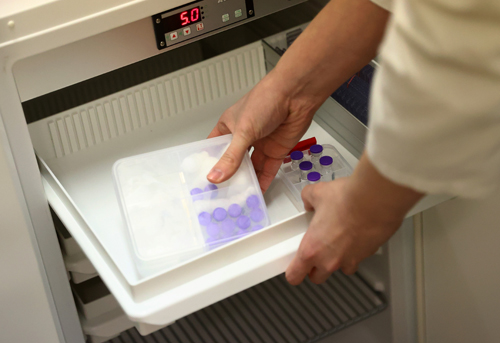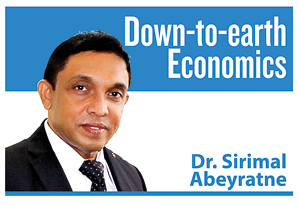First the rich, then the poor
View(s):
A member of a German Red Cross mobile vaccination team takes a box with the Pfizer-BioNTech COVID-19 vaccine out of a freezer as the team leaves to vaccinate employees and inhabitants of a retirement nursery in Dillenburg, Germany, January 7, 2021. REUTERS/Kai Pfaffenbach
Once while teaching in a class, I posed a question to the students:
“How many of you think that you are poor?”
The students gave me a surprised look at this unexpected question. I made my question clear and asked again, convincing them that what they heard was what I asked:
“My question is that how many of you think that ‘you are poor as you are from a poor family?’ Let me see your hands, if you think so.”
Surprisingly, this time I saw everyone raising their hand! I was confused by their response. I questioned myself whether they think of their families subjectively or their families representing the nation, objectively. When I looked around at the class of 60 plus students, however, I noticed just two students who kept their hands down. I went towards the two and asked them: “All the others raised their hands. It seems that only two of you have decided not to do so; why?”
“I am not poor, Sir; I never thought I was”. One of them answered. The other also nodded his head in agreement.
I have so many unfaded memories of my years of experience as a university teacher. This incident, which happened many years ago, is one of those unfaded memories.
Status of mind
In fact, I didn’t know whether the two students were rich by any means. Neither did I know whether the other students were poor. Usually, a class in a state university in Sri Lanka, unlike a school in a particular location, is represented by a wider social spectrum of the country. However, I never expected that all the students, except two, would identify themselves as coming from “poor” family backgrounds. In fact, it is not so.
Nevertheless, I realized that poverty is not necessarily the status of a person, but also a status of mind. It is not always a condition that some people must face in life; it can also be an attitude or even a choice of some people. As long as it is a status of mind, I believe, it is difficult to overcome poverty. It confirms the fact that, before poverty is eliminated from a society, it must be eliminated from the mind!
Let’s look at “poverty” objectively. According to the “national poverty line” which is the minimum expenditure required by a person to fulfill the basic needs for survival, there were about 843,913 poor people in 2016 in Sri Lanka. The national poverty line for 2016 is Rs.4,166 which has increased by Rs. 1,000 over the past five years.
If we go by the international poverty line of US$ 3.20 a day, there are 2.3 million “poor” in Sri Lanka who earn less than Rs. 600 a day; this means that more than 10 per cent of Sri Lankans are poor! If we adopt a higher international poverty line of US$ 5.50 a day, then there are 8.8 million “poor” in the country, who earn about Rs. 1,000 a day. If it is the case of poverty in Sri Lanka, in fact, 42 per cent of our people are “poor” by international standards.
Poor people, poor nations
Just like having poor people and rich people, there are also poor nations and rich nations. According to World Bank’s country classification by per capita income levels, out of 218 countries in the world, there are 89 “high-income” rich countries; these countries have a per capita income of over $12,535. However, the average per capita income for the high-income countries is $45,353, the upper boundary of high per capita income rises above its average level for some of the Scandinavian and European countries as well as for Canada, the US, Singapore and Hong Kong.
Middle-income countries are divided into two groups as “upper-middle-income” category with per capita income between $4,046 – 12,534, and “lower-middle-income” category as per capita income between $1,036 – 4,045. There are 56 countries in the “upper-middle-income” category, while their average per capita income is $9,064. There are 50 countries in the “lower-middle-income” category, while their average per capita income is $2,176.
The poorest group of countries – the category of “low-income” countries, with per capita income lower than $1,035 included 29 countries. While most of the low-income countries are from Africa, there are two Asian countries too – war-torn Afghanistan and isolated North Korea.
Poverty is evil, whether it is about poverty of people or of nations. The “poor” are the last to receive any good thing out of what the “rich” enjoy, while it is also often at the mercy of the rich. For this reason, the poor often try to live and work among the rich; that’s why people choose to go to rich countries leaving their homeland.
Save the rich first
Even if there is insufficient information and confirmation about the efficacy of the new COVID vaccines – not just one, but as many as 12 brands from many different pharmaceutical companies -, the countries have already started ordering and vaccinating their people. They are the rich nations, which can afford to buy the vaccination first and in big quantities irrespective of their cost, while the poor nations are still waiting at the mercy of others.
 According to Bloomberg’s global distribution of COVID vaccine tracker information as published on January 6, Canada has the highest vaccine doses over 300 per cent population coverage. Then the UK, Australia and New Zealand also disclosed the contracts of doses to be purchased covering over 200 per cent of the respective populations. Most of the European countries as well as the US, Chile, Israel, Japan, Mexico, and Uzbekistan have also secured contracts of vaccine doses over 100 per cent of the populations.
According to Bloomberg’s global distribution of COVID vaccine tracker information as published on January 6, Canada has the highest vaccine doses over 300 per cent population coverage. Then the UK, Australia and New Zealand also disclosed the contracts of doses to be purchased covering over 200 per cent of the respective populations. Most of the European countries as well as the US, Chile, Israel, Japan, Mexico, and Uzbekistan have also secured contracts of vaccine doses over 100 per cent of the populations.
Then we have most of the poor nations from Asia, Africa and Latin America, which have disclosed their contracts of vaccine doses less than 100 per cent of the population – even as low as 5 per cent of the population.
If the performance level of COVID vaccines is as effective as anticipated, then it is the “rich” nations which have the ability to save their nations first. And it is revealed that the governments of poorer nations are unable to pre-order in adequate numbers. Some of these countries have been looking for external grants and loans from both multilateral and bilateral sources to finance even their smaller quantity of pre-orders. While the high prices of a vaccine dose ranging from $10 – 50 have excluded the poorer nations, the declaration of “not-for-profit” supply by the AstraZeneca vaccine manufacturer was a relief for the poorer nations. Unsurprisingly while wealthier nations have already started vaccinating their citizens, the poorer nations will have to wait – perhaps, another couple of years.
Key question
Poverty leads to inequality too. Perhaps, it is a miserable inequality in which the rich – whether it is people or nations -, can afford to enjoy the benefits of development, while the poor has no choice to get access even to basic needs for their survival.
The question in issue is that, Sri Lanka has been a so-called “welfare state” for almost three-quarters of a century, looking after the poor well with our extensive welfare system. However, it does not mean at all that the country as a nation is “rich” now; we are still at the mercy of someone else. Neither does it means that doing the same thing over and over would lead to a different result. Perhaps, it is a valid question to ask as to which policies and strategies would lead us to rise as a rich nation so that we will have no need to be at the mercy of someone else.
(The writer is a Professor of Economics at the University of Colombo and can be reached at sirimal@econ.cmb.ac.lk and follow on Twitter @SirimalAshoka).


